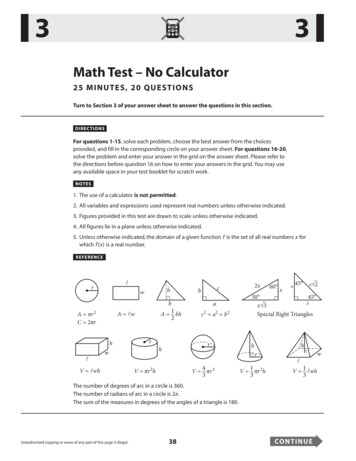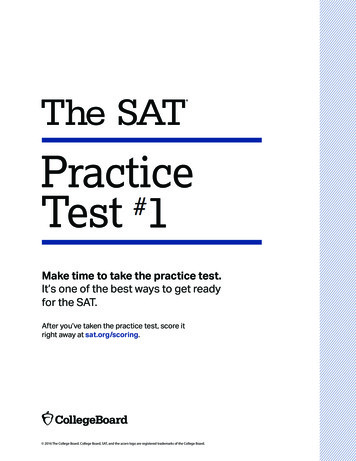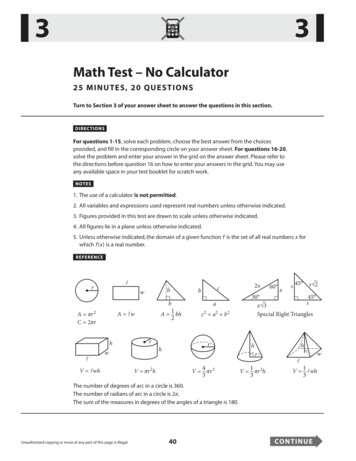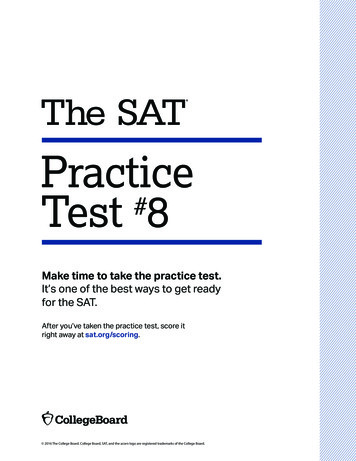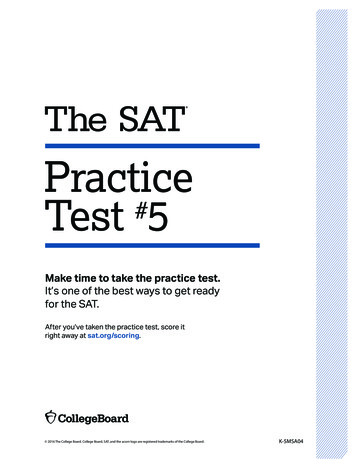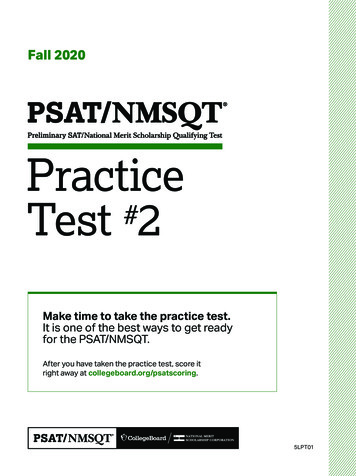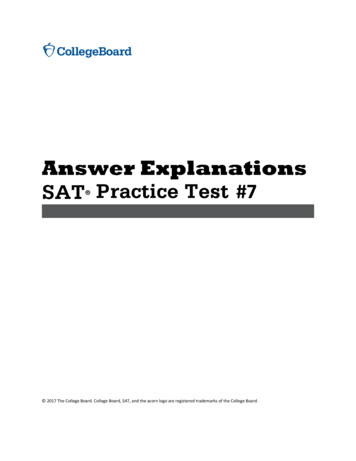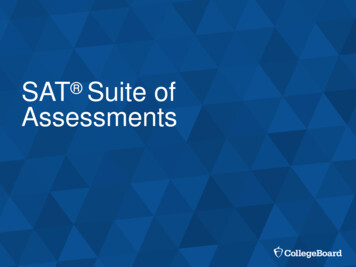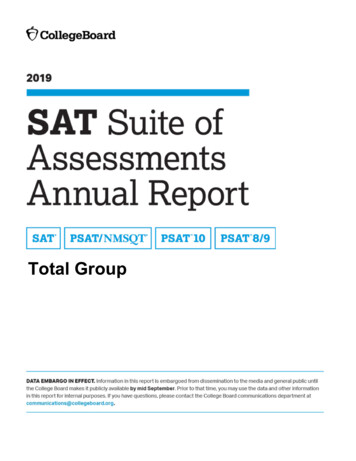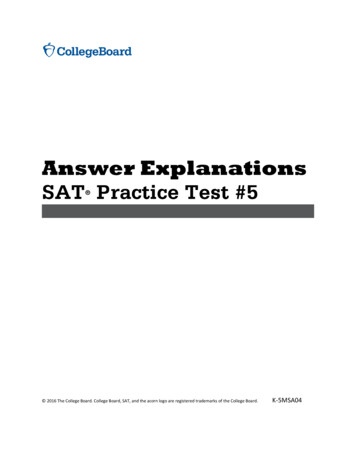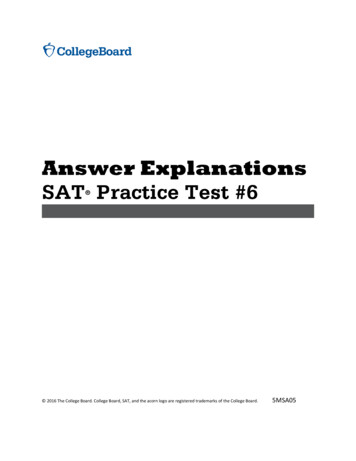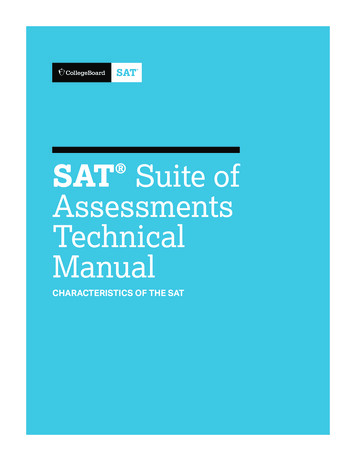
Transcription
SAT Suite ofAssessmentsTechnicalManual CHARACTERISTICS OF THE SAT1
SAT Suite ofAssessmentsTechnical ManualCHARACTERISTICS OF THE SATDecember 2017
ContentsiiiForewordivContributorsvPrefacevPurpose of Manual11. Overviewv151121Manual Contents1.1 Introduction1.2 Brief History of Development1.3 Description of Content2. Fairness212.1 What Is Fairness?252.3 Test Accommodations to Remove Construct-Irrelevant Barriers222626272.2 Fairness Reviews of Items, Forms, and Prompts forthe SAT and the PSAT-Related Assessments2.4 Subgroup Differences on the SAT and the PSAT-Related Assessments2.5 Differential Validity and Prediction Analyses for the SAT with FYGPA3. Test Development Procedures283.1 Test Specifications463.3 Test Form Assembly39474951535358 2017 The College Board.3.2 Item Development for the SAT Suite of AssessmentsReading, Writing and Language, and Math Tests3.4 Passage and Prompt Development for the SAT Essay3.5 Accommodated Forms3.6 Test Form Production4. Testing Requirements4.1 Administration4.2 SecuritySAT Suite of Assessments Technical Manuali
60 5. Interpretation and Application of Results60 5.1 Scoring Procedures66 5.2 Test Security Analyses68 5.3 Reporting72 5.4 SAT Skills Insight75 6. Psychometrics75 6.1 Scaling82 6.2 Equating91 6.3 Normative Information100 6.4 Reliability103 6.5 Psychometric Applications107 7. Validity107 7.1 Introduction to Validity as a Concept108 7.2 Content-Oriented Validity Evidence114 7.3 The Relationship Between the SAT and Other Similar Assessments120 7.4 The Relationship Between the SAT and College Outcomes133 7.5 Measuring and Monitoring College Readiness with the SAT136 7.6 Year-Over-Year Growth and PSAT-Related Benchmarks140 References143 Glossary 2017 The College Board.SAT Suite of Assessments Technical Manualii
ForewordIn 2013, the College Board embarked on one of its largest initiatives ever: the redesign ofits flagship program, the SAT, and its related assessment, the PSAT/NMSQT. This redesigneffort was driven by the lack of progress we’ve seen in the last decade to increase thecollege readiness rates of our high school graduates, which demanded that we do somethingdifferent. Simply redesigning the SAT would not be sufficient. So we, as an organization, tookon the challenge of doing more than simply designing a Suite of Assessments that wouldreport test scores. We determined that we would also deliver opportunities to middle schooland high school students, to help them successfully navigate the path to college.In 2015-16, we introduced the redesigned SAT and three PSAT-related assessments:PSAT/NMSQT, PSAT 10, and PSAT 8/9, comprising the SAT Suite of Assessments. Not only dothese assessments measure the skills and knowledge needed for college readiness at gradeappropriate levels, but each of these assessments is also scaled to a single, common metric.The result is a longitudinal assessment system, beginning in grade 8 and continuing throughgrade 12, that helps students and teachers monitor progress toward college readiness andcan start early in the preparation process, when effective interventions can be made.The SAT Suite connects students to opportunities to help them navigate the path to college,including: deep practice of college readiness skills through our partnership with KhanAcademy (available to all students free of charge); an expanding array of college scholarshipsthat make it possible for more students to defray the rising costs of higher education; anincrease in the number and kinds of fee waivers for income-eligible students, not only for theassessments but for college applications; and educational and career planning tools to helpstudents explore their interests, identify possible college majors based on those interests,and choose colleges to which they want to apply.It’s important to recognize that we could only demand more of assessment if the SAT Suiteproved to be technically sound; effectively serving its stated purposes and providing welldocumented evidence of its psychometric properties.This Technical Manual documents the processes and outcomes of the design of the SATSuite of Assessments. More importantly, this Manual represents a baseline of evidencesupporting the test development and psychometric quality of the Suite. The Manual will besupplemented each year as the Suite is administered to more and more students nationallyand internationally. Research-based evidence is the hallmark of College Board’s work, and wewill continue to evaluate and refine our assessments and how they can be effectively used topromote student readiness based on the results of our ongoing research.I am proud of the hard work that went into the design of the SAT Suite of Assessments and into thedevelopment of this Technical Manual. The many College Board team members who contributedto this Manual were committed to presenting this documentation in an easy-to-read format, withclear, concise evidence supporting the stated uses of the assessments. Ultimately, those whointerpret and use the SAT Suite will evaluate whether we achieved these goals. We welcome anyand all suggestions for improvement as we continue to update this Manual in the future.Cynthia Board SchmeiserSpecial Advisor to the PresidentThe College Board 2017 The College Board.SAT Suite of Assessments Technical Manualiii
ContributorsThe following individuals were involved in the creation of the SAT Suite of AssessmentsTechnical Manual. We thank them for sharing so generously of their time, effort, andexpertise.Chapter LeadsHui Deng, Emily Shaw, Jane Dapkus, Andrew Courchane, Sherral Miller, Cynthia SchmeiserWriters/ReviewersMaureen Ewing, Tim Moses, YoungKoung Kim, Judit Antal, Amy Hendrickson, Pamela Kaliski,Michael Chajewski, Rosemary Reshetar, Michael Walker, Weiwei Cui, Joseph Grochowalski,Burcu Kaniskan, Anita Rawls, Xiuyuan Zhang, Lei Wan, Chuah Siang Chee, Thomas Proctor,Priyank Patel, Nikhil Pargaonkar, Jay Happel, Paula Cunningham, Carly Bonar, Jim Patterson,Daming Zhu, Nancy Burkholder, Rosa Baek, Martha Bell, Jennifer Karan, Aaron LemonStrauss, Martha Morris, Stephanie Morrison, Jennifer Merriman, Kelly Godfrey, JessicaMarini, Jeffrey Wyatt, Sanja Jagesic, Betsey Walters, Suzette Stone BusaTechnical Manual Working GroupMark Syp, Chief EditorTim Moses, Chief PsychometricianOliver Zhang, Group LeadGail Mitnik, Project ManagerKarin O’Connor, Quality Control SupportLen Carmichael, Quality Control SupportLeadership ReviewersKevin Sweeney, PsychometricsSherral Miller, Assessment Design and DevelopmentJane Dapkus, College Readiness AssessmentsCynthia Schmeiser, Office of the PresidentRosemary Reshetar, PsychometricsSpecial ThanksJack Buckley, Gerald Melican, Carol Whang, Kristopher John 2017 The College Board.SAT Suite of Assessments Technical Manualiv
PrefacePurpose of ManualThe purpose of this technical manual is to provide higher education, K–12 educators,students, and any others who use or who are interested in using the SAT Suite ofAssessments with information about the technical qualities of the SAT Suite. This manualcontains information pertaining to the purpose of the assessments and the rationaleand principles behind the SAT Suite. It also includes the content of the assessments; theprocedures and processes that are undertaken in the creation, administration, and scoringof the assessments; how to interpret SAT Suite scores; the accuracy of the scores from ameasurement perspective; and evidence that bears on the validity of interpretations madeon the basis of the scores.The College Board believes that it is essential to provide documentation of this nature,in keeping with our organization’s commitment to transparency and our desire to adhereto industry best practices and the AERA/APA/NCME Standards governing supportingdocumentation for tests (found in Chapter 7 of the 2014 AERA/APA/NCME Standards forEducational and Psychological Testing). Maintaining assessments with strong evidence ofvalidity supporting them is an ongoing process, particularly in light of the recent SAT Suiteredesign, the operational data for which will be reported over the next few years. To thisend, this manual was conceived as a “living document,” and in order to keep the informationin the manual as current as possible for users (Standard 7.14), it will be updated as moreinformation becomes available.It is important to note that the information in this manual pertains to the redesigned SAT thatwas first administered in March 2016. For our purposes, this will be the test we are referringto when we use the term “SAT.” When necessary to draw a distinction between this iterationof the test and that administered prior to March 2016, we will use the terms “new SAT” and“old SAT,” respectively. Similarly, when we use the terms “PSAT/NMSQT ,” “PSAT 10,” or“PSAT 8/9,” we are referring to the tests first administered in fall 2015. When necessary todraw a distinction between this iteration and prior ones, we will use “new” and “old” the sameway they are used when discussing the SAT.Manual ContentsFor ease of reading and understanding, this manual is structured in a manner matchingthat of “the lifecycle of the test.” It provides insights about the SAT Suite, from ourearliest conceptions of the assessment’s design, all the way through test development,administration, scoring, and the interpretation of those scores for intended uses.As its name implies, Chapter 1: Overview provides an overview of the content of the SATSuite of Assessments and a discussion of the rationales and guiding principles behind theredesigned assessments. These guiding principles include fairness, reliability, and validity.Chapter 2: Fairness provides an examination of fairness as it relates to the SAT Suite, giventhe crucial role it plays in all stages of test design and administration. 2017 The College Board.SAT Suite of Assessments Technical Manualv
Chapter 3: Test Development Procedures moves from the principles guiding the designto the processes used to design the assessments. This chapter provides a special focuson how these efforts are essential toward creating assessments that produce scores thatare valid for their intended uses. After detailing the creation of the assessments in the testdevelopment section, Chapter 4: Testing Requirements describes the procedures used toadminister the tests, including test security measures, in a manner that supports fair andvalid uses of the tests.With the assessments having been administered, we then turn our attention toward thescores that are produced. Chapter 5: Interpretation and Application of Results looks at thescoring procedures and analyses used to ensure scores that are valid, reliable, and fair forintended uses. Chapter 6: Psychometrics takes this one step further, as it demonstrates theways in which the College Board evaluates the scores that come from our assessments.Chapter 7: Validity devotes an entire chapter to the guiding principle of validity. As thismanual hopefully makes apparent, validity considerations permeate every aspect of the SATSuite of Assessments and, in theory, can be discussed in nearly every chapter of the manual.We have chosen to address validity at this point, as it represents in a significant way theculmination of our efforts. Validity evidence takes the results of all of our previous analysesand addresses whether the assessments can be used to determine college readiness andsuccess, the overall goal of the SAT Suite. 2017 The College Board.SAT Suite of Assessments Technical Manualvi
CHAPTER 1OverviewThis section provides an overview of the SAT Suite of Assessments. It offers insight into notonly the content of the assessments in the SAT Suite but also our motivations for the recentredesign and the fundamental guiding principles behind the design of the SAT Suite.Section 1.1 takes an initial look at the SAT Suite of Assessments. In addition to providingan overview of the features of the SAT and the PSAT-related assessments, it discusses thepurpose and several of the intended uses of the assessments. The section also includes abrief primer on the concepts of validity, reliability, and fairness, with a specific focus on theirrelevance to the SAT Suite.Section 1.2 puts the SAT Suite into a broader context by providing a brief history of thedevelopment of the SAT and the PSAT-related assessments, including the redesign. Thesection offers insight into the rationale behind the redesign and the foundational tenets ofthe assessment. It also details the benefits the SAT Suite brings to students and parents,admission officers, and K–12 educators. This includes a special focus on the role thatstudent preparation, through challenging high school coursework or a more formal series oftest preparation, has on SAT outcomes.Section 1.3 is a description of the content of the SAT and PSAT-related assessments.We demonstrate how the principles and tenets discussed in the previous sections wereapplied to create assessments that provide a sound evaluation of student achievement, thebest work of the classroom, and those topics that are the most important to college andcareer readiness.1.1 IntroductionBrief Description of the SATThe SAT, the College Board’s flagship college and career readiness assessment, is a keycomponent in the SAT Suite of Assessments, which contains the SAT, PSAT/NMSQT, PSAT 10, andPSAT 8/9 as grade-appropriate assessment options for middle school and high school students.For nearly a century, the SAT has been used successfully worldwide, in combination withfactors such as high school grade point average (HSGPA), to assess student preparednessfor and to predict student success in postsecondary education. In the graduating class of2017, 1.8 million test takers took the SAT, the results of which were used by thousands ofhigh school educators and postsecondary admission officers around the world (CollegeBoard, 2016a). Since its launch in 1926, the SAT has been used to hel
was first administered in March 2016. For our purposes, this will be the test we are referring to when we use the term “SAT.” When necessary to draw a distinction between this iteration of the test and that administered prior to March 2016, we will use the terms “new SAT” and “old SAT,” respectively. Similarly, when we use the terms “PSAT/NMSQT ,” “PSAT 10,” or
